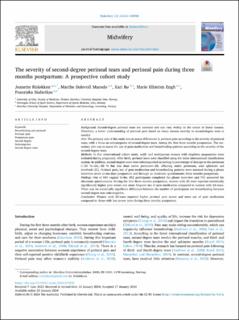| dc.contributor.author | Risløkken, Jeanette | |
| dc.contributor.author | Macedo, Marthe Dalevoll | |
| dc.contributor.author | Bø, Kari | |
| dc.contributor.author | Engh, Anna Marie Ellström | |
| dc.contributor.author | Siafarikas, Franziska | |
| dc.date.accessioned | 2024-03-18T07:45:48Z | |
| dc.date.available | 2024-03-18T07:45:48Z | |
| dc.date.created | 2024-02-07T12:53:43Z | |
| dc.date.issued | 2024-04-01 | |
| dc.identifier.citation | Midwifery. 2024, 131(April 2024), Artikkel 103930. | en_US |
| dc.identifier.issn | 0266-6138 | |
| dc.identifier.uri | https://hdl.handle.net/11250/3122771 | |
| dc.description | This is an open access article under the CC BY license (http://creativecommons.org/licenses/by/4.0/). | en_US |
| dc.description.abstract | Background: Second-degree perineal tears are common and can vary widely in the extent of tissue trauma. Therefore, a better understanding of perineal pain based on tissue trauma severity in second-degree tears is needed.
Aim: The primary aim of this study was to assess differences in perineal pain according to the severity of perineal tears, with a focus on subcategories of second-degree tears, during the first three months postpartum. The secondary aim was to assess the use of pain medication and breastfeeding patterns according to the severity of the second-degree tears.
Methods: In this observational cohort study, nulli- and multiparous women with singleton pregnancies were included during pregnancy. After birth, perineal tears were classified using the latest international classification system. In addition, second-degree tears were subcategorised according to percentage of damage to the perineum (<50 %=2A,>50 % but less than entire perineum=2B, affecting entire perineum, anal sphincter not involved=2C). Perineal pain, use of pain medication and breastfeeding patterns were assessed during a phone interview seven to ten days postpartum and through an electronic questionnaire three months postpartum.
Findings: Out of 880 vaginal births, 852 participants completed the phone interview and 715 answered the electronic questionnaire. During the first three months postpartum, women with 2C-tears reported statistically significantly higher pain scores and more frequent use of pain medication compared to women with 2A-tears. There was no statistically significant difference between the number of participants not breastfeeding between second-degree tear subcategories.
Conclusion: Women with 2C-tears reported higher perineal pain scores and more use of pain medication compared to those with less severe tears during three months postpartum. | en_US |
| dc.language.iso | eng | en_US |
| dc.rights | Navngivelse 4.0 Internasjonal | * |
| dc.rights.uri | http://creativecommons.org/licenses/by/4.0/deed.no | * |
| dc.subject | breastfeeding | en_US |
| dc.subject | perineal | en_US |
| dc.subject | perineal pain | en_US |
| dc.subject | postpartum pain | en_US |
| dc.subject | second degree | en_US |
| dc.subject | second degree tears | en_US |
| dc.title | The severity of second-degree perineal tears and perineal pain during three months postpartum: A prospective cohort study | en_US |
| dc.type | Peer reviewed | en_US |
| dc.type | Journal article | en_US |
| dc.description.version | publishedVersion | en_US |
| dc.rights.holder | © 2024 The Author(s) | en_US |
| dc.source.pagenumber | 8 | en_US |
| dc.source.volume | 131 | en_US |
| dc.source.journal | Midwifery | en_US |
| dc.identifier.doi | 10.1016/j.midw.2024.103930 | |
| dc.identifier.cristin | 2244034 | |
| dc.description.localcode | Institutt for idrettsmedisinske fag / Department of Sports Medicine | en_US |
| dc.source.articlenumber | 103930 | en_US |
| cristin.ispublished | true | |
| cristin.fulltext | original | |
| cristin.qualitycode | 1 | |


